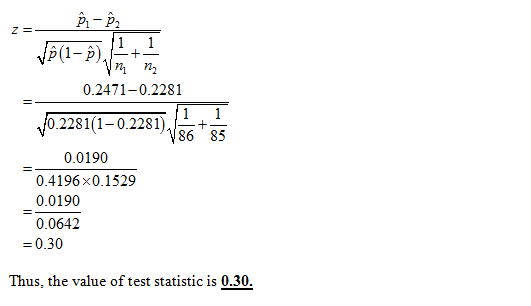Would you favor spending more federal tax money on the arts? Of a random sample of n1 = 86 politically conservative voters, r1 = 18 responded yes. Another random sample of n2 = 85 politically moderate voters showed that r2 = 21 responded yes. Does this information indicate that the population proportion of conservative voters inclined to spend more federal tax money on funding the arts is less than the proportion of moderate voters so inclined? Use α = 0.05. (a) State the null and alternate hypotheses. H0: p1 = p2; H1: p1 > p2 H0: p1 = p2; H1: p1 < p2 H0: p1 = p2; H1: p1 ≠ p2 H0: p1 < p2; H1: p1 = p2 (b) What sampling distribution will you use? What assumptions are you making? The Student's t. The number of trials is sufficiently large. The standard normal. The number of trials is sufficiently large. The standard normal. We assume the population distributions are approximately normal. The Student's t. We assume the population distributions are approximately normal. (c)What is the value of the sample test statistic? (Test the difference p1 − p2. Do not use rounded values. Round your final answer to two decimal places.) (d) Find (or estimate) the P-value. (Round your answer to four decimal places.) (e) Based on your answers in parts (a) to (c), will you reject or fail to reject the null hypothesis? Are the data statistically significant at level α? At the α = 0.05 level, we reject the null hypothesis and conclude the data are statistically significant. At the α = 0.05 level, we fail to reject the null hypothesis and conclude the data are statistically significant. At the α = 0.05 level, we fail to reject the null hypothesis and conclude the data are not statistically significant. At the α = 0.05 level, we reject the null hypothesis and conclude the data are not statistically significant. (f) Interpret your conclusion in the context of the application. Reject the null hypothesis, there is sufficient evidence that the proportion of conservative voters favoring more tax dollars for the arts is less than the proportion of moderate voters. Fail to reject the null hypothesis, there is sufficient evidence that the proportion of conservative voters favoring more tax dollars for the arts is less than the proportion of moderate voters. Fail to reject the null hypothesis, there is insufficient evidence that the proportion of conservative voters favoring more tax dollars for the arts is less than the proportion of moderate voters. Reject the null hypothesis, there is insufficient evidence that the proportion of conservative voters favoring more tax dollars for the arts is less than the proportion of moderate voters.
Would you favor spending more federal tax money on the arts? Of a random sample of n1 = 86 politically conservative voters, r1 = 18 responded yes. Another random sample of n2 = 85 politically moderate voters showed that r2 = 21 responded yes. Does this information indicate that the population proportion of conservative voters inclined to spend more federal tax money on funding the arts is less than the proportion of moderate voters so inclined? Use α = 0.05.
(b) What sampling distribution will you use? What assumptions are you making?
(c)What is the value of the sample test statistic? (Test the difference p1 − p2. Do not use rounded values. Round your final answer to two decimal places.)
(d) Find (or estimate) the P-value. (Round your answer to four decimal places.)
(e) Based on your answers in parts (a) to (c), will you reject or fail to reject the null hypothesis? Are the data statistically significant at level α?
(f) Interpret your conclusion in the context of the application.
State the hypotheses.
Let p1 denotes the population proportion of conservative voters.
Let p2 denotes the population proportion of moderate voters.

That is, there is no evidence to conclude that the population proportion of conservative voters inclined to spend more federal tax money on funding the arts is less than the proportion of moderate voters.

That is, there is evidence to conclude that the population proportion of conservative voters inclined to spend more federal tax money on funding the arts is less than the proportion of moderate voters.
Correct option: Option 2



Moreover the two samples are randomly selected and are independent to each other.
Since, all the conditions have been satisfied the listed assumptions are turned to be realistic The standard normal. We assume the population distributions are approximately normal.
Correct option: The standard normal. We assume the population distributions are approximately normal.
Obtain the value of the test statistic.
The value of test statistic is obtained below:
The value of sample proportion1,

The required value of test statistic is,

Step by step
Solved in 6 steps with 8 images









